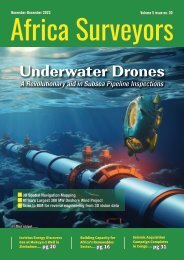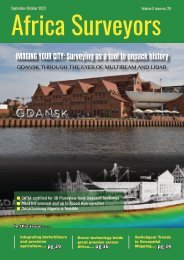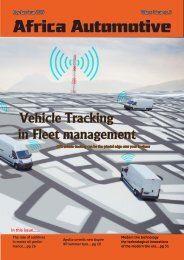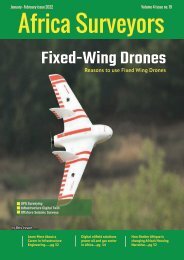Africa Surveyors May-June issue 2023 digital
Africa Surveyors is Africa’s premier source of Surveying, Mapping and Geospatial news and an envoy of surveying products/service for the Construction, Maritime, Onshore & Offshore energy and exploration, Engineering, Oil and Gas, Agricultural and Mining sectors on new solution based trends and technology for the African market.
Africa Surveyors is Africa’s premier source of Surveying, Mapping and Geospatial news and an envoy of surveying products/service for the Construction, Maritime, Onshore & Offshore energy and exploration, Engineering, Oil and Gas, Agricultural and Mining sectors on new solution based trends and technology for the African market.
Create successful ePaper yourself
Turn your PDF publications into a flip-book with our unique Google optimized e-Paper software.
UXO SURVEYING<br />
Stephen Wilson, Director of<br />
Business Development & UXO<br />
Manager - EPI Group<br />
Alexey Dobrovolskiy, Chief<br />
Technology Officer - SPH<br />
Engineering<br />
Thomas Mennerdahl, Technology<br />
Director Subsea - Reach Subsea<br />
AS<br />
Vincent van Santen, Business<br />
Development Manager Offshore<br />
Wind and UXO - Fugro<br />
the site's particular conditions, the target's features, and the survey's<br />
goals,” says Vincent. “To achieve reliable and accurate identification of<br />
UXO artefacts, automated detection approaches are often combined<br />
with human experience and visual confirmation. Multiple detection<br />
techniques to identify potential UXO objects can be applies in<br />
the seabed, electromagnetic signals being one of them. The latest<br />
developments in data processing algorithms can also be used to<br />
improve processing time and ensure methods are objective, repeatable<br />
and auditable,” he adds.<br />
“The utilisation of this emerging broadband electromagnetic<br />
technology could allow for superior detections when compared to<br />
most technologies currently available. The purpose of UXO survey<br />
techniques is to produce a master target list of potential pUXO, which<br />
will need to be investigated prior to ALARP. It is imperative that we<br />
do not miss pUXO and that we do not unnecessarily add pUXO to<br />
the master target list, as investigation is a very expensive process,”<br />
observed Stephen.<br />
During the initial phase of a technical UXO survey, a range of<br />
different sensor methods are deployed. This phase requires a deep<br />
understanding of the type of munitions, geophysical survey methods,<br />
data processing and management skills.<br />
Innovative technologies for UXO surveys<br />
When it comes to best technologies for land-based UXO surveys,<br />
Allison affirms that Ground Penetrating Radar is complementary to<br />
other detection methods. “GPR uses low energy, high frequency radio<br />
waves to image metallic and non-metallic objects in the subsurface,<br />
making it a natural technology to use for locating buried UXO. There is<br />
a wide selection of GPR systems and configurations available, making<br />
GPR adaptable to different terrains for UXO applications”, she adds.<br />
Moreover, magnetometers are subject to systematic errors inherent to<br />
the sensor itself and the magnetic environment it is placed in. These<br />
errors are induced by hard and soft iron effects, zero bias errors, scale<br />
factors and non-orthogonality- which will show up as an orientationand<br />
movement induced noise on the measured total magnetic field.<br />
The sources of these magnetic influences are the sensor, the sensor<br />
platform and the surface vessel (in shallow water); this is with regards<br />
to Thomas.<br />
“In late 2000s ROV based gradiometer systems were introduced which<br />
has advantages but also some challenges. The main reason why<br />
magnetometers measuring total field are very complicated to use on<br />
ROVs, is due to the noise induced by the motion of the ROV/vessel<br />
in relation to the magnetometer which will change the measured<br />
magnetic field,” he adds. Additionally, Thomas is certain that, “The<br />
main solution to this is the use of two or more magnetometers in a<br />
gradiometer configuration. In such a setup, the influence on the total<br />
field from the surface vessel is assumed to be equal on all sensors due<br />
to the relative distance between the ROV and the surface vessel, and<br />
the distance between the magnetometers in the array. As this is not<br />
the case for the targets located on the seabed, this method does not<br />
suppress any data of interest in an archaeological or sea based UXO<br />
survey.”<br />
“When there is a risk for non-ferrous UXOs or there are subsea<br />
structures and/or geology/boulders that could mask the magnetic<br />
signature of a possible UXO target a ROV based electromagnetic<br />
system or 3D chirp system can be an appropriate solution. In shallow<br />
water the 3D chirp could be fitted to the surface vessel without<br />
requirement for ROV or towed solutions,” adds Thomas.<br />
“Once the fact that intervention into a UXO contaminated area, for<br />
survey or clearance, is determined, factors have to be taken into<br />
consideration for the best suited and most practicable technologies or<br />
techniques required. For example, the most up to date third generation<br />
detection equipment may not be suitable for very simple small-scale<br />
contamination; or time and speed of clearance may be the precedence<br />
over cost of such high-end technologies (and techniques such as<br />
mechanical clearance with armoured earth moving machines)” clinches<br />
Steve.<br />
In recent decades, a number of new and innovative technologies have<br />
been developed to improve the detection of UXOs. These include<br />
<strong>digital</strong> geophysics and a combination of electromagnetic sensors.<br />
Combined with data analysis workflows, these technologies can<br />
greatly improve the accuracy of locating UXOs.<br />
The opinions expressed by individual experts are their sole<br />
responsibility and do not imply any endorsement or support<br />
by other participants in this context.<br />
www.africasurveyorsonline.com<br />
<strong>May</strong>-<strong>June</strong> <strong>issue</strong> l <strong>2023</strong> 15

















